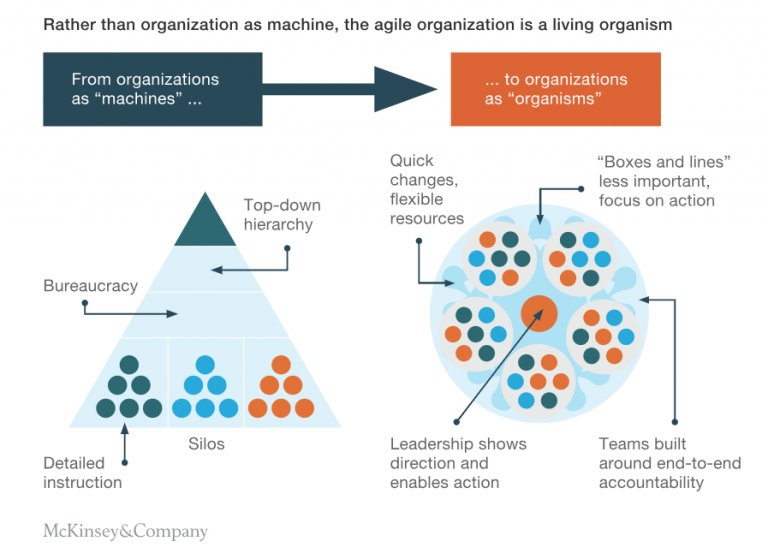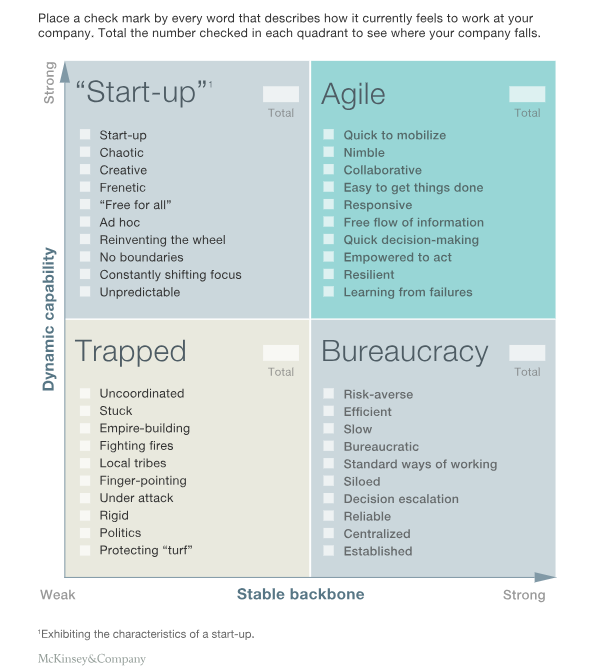22 Benefits of the Agile Organisation
Times are changing quickly and the business environment must adapt and keep up.
In this article we are looking into the benefits of the agile organisation.
Challenges of the digital business environment
McKinsey & Company have identified 4 challenges brought by the digital revolution that is transforming industries, economies, and societies:
1. Quickly evolving environment
Stakeholders’ demands are changing. Customers, partners, and regulators have pressing needs. Investors are demanding growth. Competitors and collaborators demand action to accommodate fast-changing priorities.
2. Constant introduction of disruptive technology
Businesses and industries are replaced through digitization. Examples of disruptive technologies and new means of communication are AR and VR, machine learning, chatbots, messaging platforms, AI etc
3. Accelerating digitization and democratization of information
Information has increased in volume, transparency and distribution which require organizations to rapidly engage in multidirectional communication and complex collaboration with customers, partners, and colleagues.
4. Acquiring and retaining talent
It’s more difficult for brands and companies to attract and retain valuable employees. Times are also changing in the recruiting domain as the Global Recruiting Trends 2018 study by LinkedIn shows. The professional platform identified 4 recruiting trends which companies must take into account when setting their hiring processes into motion: diversity, new interviewing tools, data and Artificial Intelligence. Discover how to ride the trend waves in our article.
The trends described above are dramatically changing how organizations and employees work. What, then, will be the dominant organizational paradigm for the next 100 years? How will companies balance stability and dynamism? Moreover, which companies will dominate their market and attract the best talent?”
McKinsey & Company
Organisations as machines was a business model introduced in the 1900s by the Ford Motor Company. Such organisations were hierarchical and specialized – depicted as machines. The business historians describe the century from 1911 to 2011 as “the management century.” But the digital world called upon organisations to change their business model and turn from machine to organism.
Stop looking at your organisation as a machine. Start looking at it as a living organism.
 image source: mckinsey.com
image source: mckinsey.com
Much like a living organism, businesses adapt rapidly to new environments, find solutions to challenges and redirect resources wherever they are needed.
Stable or dynamic? Achieve both through agility
Over the past decade, McKinsey & Company have studied the impact of a wide range of management practices on different dimensions of organizational health. They surveyed more than two million respondents at over 1,000 companies. The resulted study has become a stable baseline for understanding the contributions of specific organizational and leadership characteristics to the health, positive and negative, of the companies in their sample.
From November 2013 to October 2014, the McKinsey researchers added questions, for the first time, on speed and flexibility. They described the companies that combined speed and stability as agile.
Agile Organisations – Main Features
To survive and thrive in the new environment, organisations need to change from traditional to agile. Agile organisations achieve the much-needed balance between dynamic and stable being both at the same time.
Here are the features of agile organisations:
- They design stable backbone elements;
- These elements evolve slowly and support dynamic capabilities;
- They can adapt quickly to new challenges and opportunities;
- They mobilize quickly;
- They are nimble;
- They are empowered to act;
- They make it easy for their employees to act;
- Role clarity and operational discipline are highly ranked practices;
- They are powerful machines for innovation and learning;
- They strong at motivation;
- Thet have high organisational health;
- They show a strong relationship between organizational health and the creation of value.
Organisational agility gives your business the competitive edge it needs in a digital world.
Organisational agility – the Benefits
Here are the benefits of organisational agility via McKinsey & Company and Devopsdigest:
- Greater customer centricity,
- Faster time to market;
- Higher revenue growth;
- Lower costs;
- A more engaged workforce;
- Better alignment between product management and R&D;
- A more effective and productive connection between Development and Operations and the business to deliver tangible, long-term value;
- Measurable gains in efficiency, cycle time, and quality;
- Improved ability to implement software fixes and adjustments quickly and easily;
- Rapidly detect and eliminate errors;
- Accelerated business;
- Continuous feedback;
- Reduced time of delivery;
- More likely to meet actual business requirements;
- Data visibility at all levels, and for anybody who is a stakeholder or part of the team;
- The ability to work across several teams and sites, while staying efficient;
- Being able to embrace and respond to changing business demands and requirements;
- The ability to adapt to change;
- Faster innovations with less risk;
- Create value in failure by turning it into the opposite of risk – knowledge;
- The ability to implement enterprise systems in days or weeks, not months or years;
- Rapidly and easily incorporate new technologies and methods.
The great advantage of being agile is the multiple feedback loops you establish and how it can accelerate your business. The first set of feedback loops are between your delivery teams and your stakeholders to ensure the teams are delivering the right things (value), delivering the right way (quality), and continuing to improve on this capability. But what many don’t realize is the second set of feedback loops that come into play later as elements of the business (engineering, support, marketing, sales, etc.) establish stronger feedback loops internally to build a shared perspective and see trends that competitors cannot easily see. This is when truly disruptive innovation occurs, grows and accelerate your business.
Mark Kilby, Agile Coach, Sonatype (quote via devopsdigest.com)
The Employees – a surprise outcome of agile organisations
Besides quantifiable results such as sales, revenues and other business indicators which high management can write on spreadsheets and reports, agility experts move the spotlight to a different corner: the employees.
The agile organisations allow their employees to connect in a way which traditional organisations cannot. This connection leads to better collaboration between teams with positive results on their work.
The real revolution of Agile (and the wellspring of its success) is that it has established a framework for conversation and innovation wherein people are discovering the incredible results that can come from learning to understand, respect, and trust each other more openly.
Jason J. Lenny, Technical Product Director, XebiaLabs (quote via devopsdigest.com)
